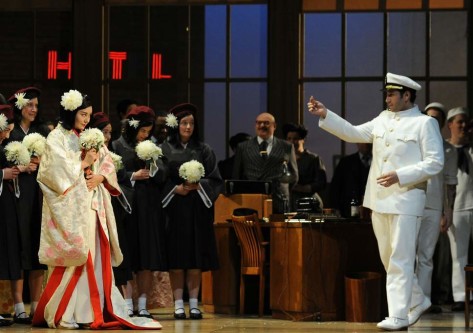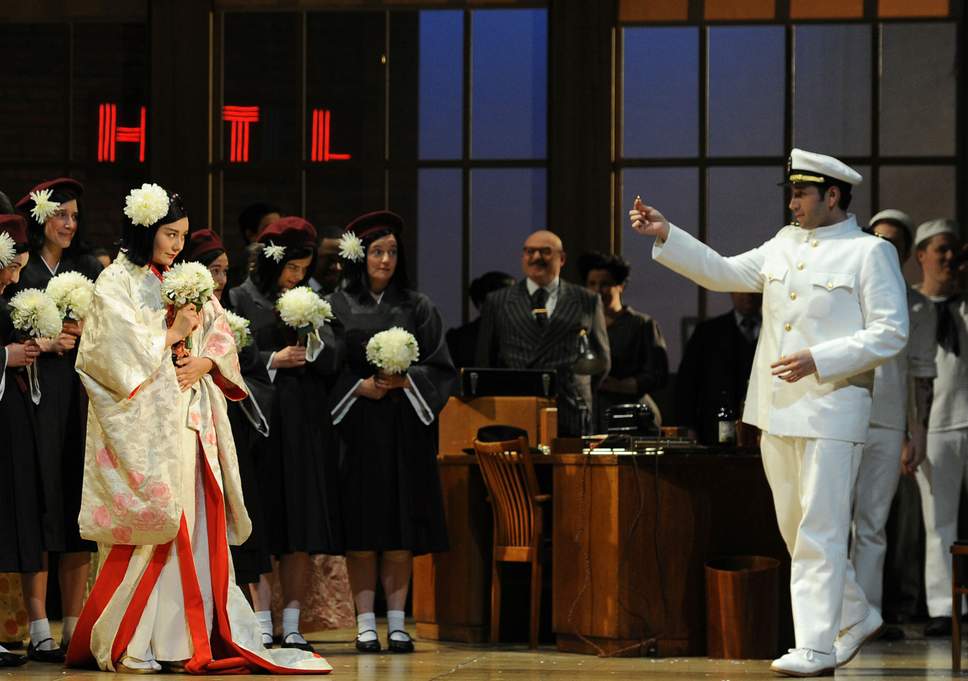 United Kingdom 2018 Glyndebourne Festival Opera – Puccini, Madama Butterfly: Soloists, The Glyndebourne Chorus, London Philharmonic Orchestra / Omer Meir Wellber (conductor). Directed for the screen by François Roussillon and broadcast to Cineworld Basildon, 21.6.2018. (JPr)
United Kingdom 2018 Glyndebourne Festival Opera – Puccini, Madama Butterfly: Soloists, The Glyndebourne Chorus, London Philharmonic Orchestra / Omer Meir Wellber (conductor). Directed for the screen by François Roussillon and broadcast to Cineworld Basildon, 21.6.2018. (JPr)

Production:
Director – Annilese Miskimmon
Designer – Nicky Shaw
Lighting designer – Mark Jonathan
Movement director – Kally Lloyd Jones
Video designer – Ian William Galloway
Cast includes:
Lieutenant B F Pinkerton – Joshua Guerrero
Goro – Carlo Bosi
Suzuki – Elizabeth DeShong
Sharpless – Michael Sumuel
Cio-Cio-San – Olga Busuioc
Imperial Commissioner – Michael Mofidian
Bonze – Oleg Budaratskiy
Prince Yamadori – Simon Mechlinski
Sorrow – Rupert Wade
Kate Pinkerton – Ida Ränzlöv
Let’s face it Madama Butterfly causes concern particularly in 2018 when even the BBC Proms can be accused of ‘whitewashing’ West Side Story. For a long time in the theatre an actor of a suitable ethnic background must be cast as Othello, and Fagin has become – well who knows what – but certainly not Jewish and, I suspect, Moldovan Olga Busuioc would never be cast as a 15-year-old Japanese girl! So opera seems stuck in a time warp, and let others debate this. In opera such issues are often dealt with tangentially and Otello or Aida are white singers with just a bit more bronzer than usual. As I sat through Glyndebourne’s Madama Butterfly I know I began to have conflicting thoughts: wouldn’t it have been good to have an Asian singer in the title role or, on the other hand, works like this are what they are and belong to the time they are written. What is for sure though is that Madama Butterfly, despite its music, has never been merely a romantic love story and all credit to Annilese Miskimmon for making her production – first seen in 2016 during the Glyndebourne Tour – so thought-provoking.
Among Madama Butterfly’s other problems are the toasts – however ironic Puccini might intentionally or otherwise have been – to the greatness of the America (or ‘God’s America’ at one point). However, it is the acceptance of the ‘pleasures’ of sex tourism that can be particularly worrying in this opera. The acceptability of underage sex is made clear in Act I and the libretto has Cio-Cio-San sings something like ‘Make love to me gently as if I were a baby’ and there are many moments of misogyny including ‘She babbles on like women everywhere you go’. I am not propounding gutting opera librettos to make them more acceptable for twenty-first century audiences, I am highlighting an inconsistent approach to these matters. Once again Annilese Miskimmon must be credited for addressing these dark matters head on and not soft-soaping them.
Act I takes place not in the Nagasaki house Pinkerton has rented but inside Goro’s ‘Marriage Bureau’ in Japan during the 1950s when historically GIs would have taken this opportunity to find a bride. Miskimmon in a filmed interview for this cinema broadcast explained how Goro is ‘making a lot of money arranging these marriages between westerners and young Japanese girls.’ His office becomes almost a revolving door for these sham marriages. Visual leitmotifs include wads of cash being handed over – including some to Cio-Cio-San’s own mother (Eirlys Myfanwy Davies) – and repetitions throughout the opera of a Universal International newsreel of the 1950s with the titles ‘Yanks Marry Japanese Maids’, ‘Learning To Be An American Wife’ and ‘Journey To A New Life’. Through the windows there are the neon signs of a Tattoo parlour and the hotel for, I presume, the wedding night. Nicky Shaw’s office is functionally furnished there is the hint at some marquetry trees and also a massive cabinet with many drawers all full of the folders of those ‘brides’ Goro has sold already and those he will be selling. Never has the connection between Puccini and Claude-Michel Schönberg and Alain Boublil’s Miss Saigon been clearer.
Unfortunately, an office is not really the right setting for Puccini’s climactic Act I love duet (‘Bimba, Bimba, non piangere’) unless Pinkerton was forcibly to initiate ‘consummating’ their union on Goro’s desk. Otherwise there is no reason I can think of for them to still be there. Mark Henderson gives us a few lighting effects – including a glimpse of starlight through the windows – but that is as romantic as it gets, though perhaps again perfectly ‘in tune’ with Miskimmon’s basic concept. After all this Acts II and III are played ‘straight’ with a conventional Japanese – though Americanised – house and garden where the cherry blossom is falling. Cio-Cio-San wears a Western-style pastel blue suit and stilettos. She will only put her kimono back on again before she commits suicide after losing all hope for a happy future and is willing to relinquish her son, Sorrow (a very unperturbable Rupert Wade), to Pinkerton’s new American wife, Kate (Ida Ränzlöv).
Olga Busuioc’s proved to be a remarkably convincing Japanese teenager and acted with her eyes, face and body and this was highlighted by François Roussillon’s close-up direction for the screen. Busuioc’s reactions were priceless as Pinkerton made her throw her bouquet or he asked whether she loved him. (It must be noted here that all I write about the singing and the music reflects how I heard it through cinema speakers.) Vocally Busuioc was vulnerable and naïve and the near-perfect embodiment of Puccini’s young geisha in Act I. For me the more Cio-Cio-San’s fears and anxiety took hold of her character in the final two acts Busuioc seemed to leave all trace of Japan behind and stylistically sounded more like a steely Verdi soprano. Her emotional arias ‘Un bel dì vedremo’ and ‘Tu? Tu? Piccolo iddio!’ were – as expected – the high points of her performance and showed how much Busuioc embraced Cio-Cio-San’s more worldly-wise and weary nature, although I wasn’t as moved by them as I expected I would be.
Joshua Guerrero’s Pinkerton convinced me more by his acting than his singing. He was as salute-the-American-flag stiff and implacable as any Navy lieutenant seen in gung-ho Hollywood wartime propaganda movies. Most of the cast are about halfway through a demanding season of 16 performances and I got the impression this was taking its toll on some of the voices including the two leads especially. There was appropriate ardour to all Guerrero sang but there was a tightness to the top of the voice and the mechanics of singing were etched on his face.
The most ‘complete’ performance was from the authoritative Elizabeth DeShong as Suzuki, the maid who makes it plain to us watching that she knows how there can only be one outcome – probably a tragic one – if Cio-Cio-San tries to stay ‘faithful’ to Pinkerton. It is to DeShong’s credit how pivotal she made her lesser role seems. With respect to Puccini some of the remaining characters are underwritten and singers – such as Oleg Budaratskiy (Bonze) and Simon Mechlinski (Prince Yamadori) – don’t get much to work with to make an impression. Best of the rest were Carlo Bosi’s venal Goro and Michael Sumuel’s Sharpless, the conscience-stricken and respectful US Consul, although his refulgent bass-baritone was not ideally suited to the part.
The Glyndebourne Chorus gave an excellent rendition of the ‘Humming Chorus’ and the London Philharmonic Orchestra sounded good under Omer Meir Wellber. In a backstage interview he said how Madama Butterfly ‘is a symphony with singers’ and the orchestra’s role is even more important because ’most of the things are feeling or thinking and not saying [that] we play’. This is exactly the role of the orchestra in Wagner’s operas and showed how much he had influenced Puccini when he came to compose his 1904 Madama Butterfly. Wellber clearly recognises this and it explains all the Wagnerian colours he brought out in the score during Acts II and III particularly. How much he will endear himself to the Glyndebourne public by suggesting they all return after the long interval there ‘full of food and a bit drunk’ I’ll leave others to decide. Regardless Annilese Miskimmon’s production does give much food for thought!
My concluding comment is about Katie Derham’s engaging presentation which mimicked some of the informality we see during The Met:Live in HD seasons. However, she introduced the transmission as ‘We’re live at Glyndebourne’ which we were not. Looking at their own website timings it is considerably delayed to, of course, remove the 90-minute interval and it never caught up. Nevertheless, the credits do – correctly – say the opera is ‘filmed live’ on the day.
Jim Pritchard
Madama Butterfly is available online until 28 June and for more information about this and further cinema showings click here.
